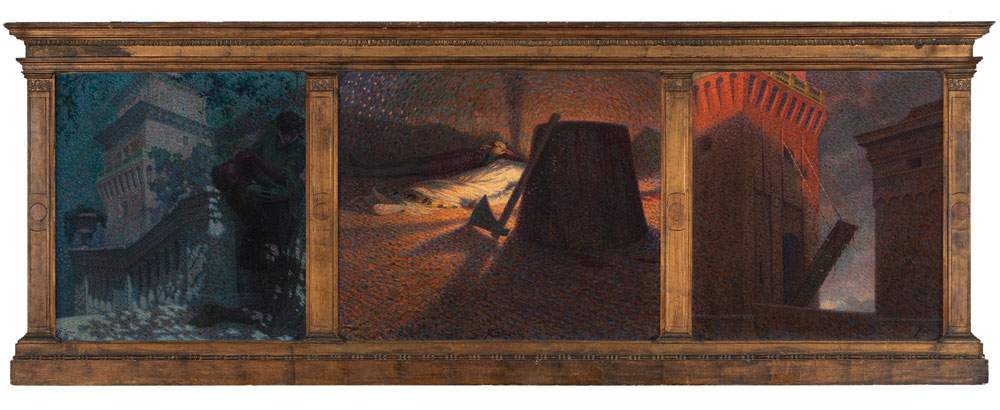A major exhibition on Giovanni Battista Crema in Ferrara, the first anthological exhibition in his hometown
The Castello Estense in Ferrara is dedicating an exhibition, more than half a century after the last monographic exhibition, to Giovanni Battista Crema (Ferrara, 1883 - Rome, 1964) until December 26, 2021. Ferrara-born but Roman by adoption, the artist worked tirelessly for more than sixty years, interpreting with his art the modernity and contradictions of the twentieth century. Curated by Manuel Carrera and Lucio Scardino, strongly desired by Vittorio Sgarbi and organized by the Ferrara Arte Foundation and the Ferrara Galleries of Modern and Contemporary Art, the exhibition entitled Giovanni Battista Crema. Beyond Divisionism brings together a selection of works from the civic collections in dialogue with important loans from museums and private collections, accompanied by previously unpublished documents from the archive of the artist’s heirs, including the touching autobiographical manuscript entitled Memorie inutili di un sopravvissuto.
From the humanitarian socialism of his early years, when he frequented Giacomo Balla’s coterie, to the mixture of realism and symbolism of his maturity, Crema’s artistic journey recounts the imagination of an artist with a strong narrative vocation, expressed in triptychs and large-scale works, but also in easel paintings and small pencil drawings.
The exhibition is divided into seven thematic sections, preceded by an introductory room in which the artist is presented through his own image, with two self-portraits from different periods and a sculptural portrait by Silverio Montaguti.
Arriving in Rome in 1903 after training between Ferrara and Naples, Crema was fascinated by Divisionist technique, a language to which he remained firmly attached throughout his life, and which he discovered by frequenting the coterie of artists around Giacomo Balla. Initially, he shared with them a fascination for proletarian subjects and social denunciation: his first important success at the annual exhibition of the Society of Amateurs and Connoisseurs of Fine Arts in Rome was in 1905, where with the triptych L’istoria dei ciechi dolorosa he came to the attention of critics. The exhibition continues with a survey of the themes of international symbolism and an excursus on Ferrara iconography, especially from the Este era, from Ugo and Parisina to Marfisa.
After a focus on portraits, scenes of domestic life and female nudes, the exhibition route restores the Ferrara painter’s experience at the front. During the war, the artist realistically depicted scenes of military life: departing soldiers, trenches, grenade launches and sieges. Crema also took an active part in World War II, when the Navy Ministry offered him a prestigious assignment: to document life aboard naval ships as a war painter.
Reflections on the themes of war contrast with those on the dual significance ofingenuity and progress, to which the last section is devoted. On loan from the Lucio Dalla Foundation, the large 1935 painting titled Century XX is exhibited here. The work is in dialogue with the panels of the monumental polyptych Itala gens, in which Crema, through a parallelism between the themes of art and faith and those of science and war, puts into painting his troubled relationship with modernity.
Image: Giovanni Battista Crema, Parisina Malatesta (1921; oil on canvas, 73 x 244 cm; Province of Ferrara) Photo by Luca Gavagna
 |
| A major exhibition on Giovanni Battista Crema in Ferrara, the first anthological exhibition in his hometown |
Warning: the translation into English of the original Italian article was created using automatic tools. We undertake to review all articles, but we do not guarantee the total absence of inaccuracies in the translation due to the program. You can find the original by clicking on the ITA button. If you find any mistake,please contact us.





























